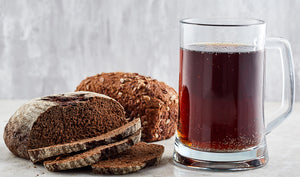Hop selection is an essential part of the brewing process. Each variety lends a different flavour, aroma and bittering profile to your brew. Whether you're looking for the right hop(s) for your own beer recipe, or looking to substitute in an existing recipe, here's a primer on hops.
Looking to grow you own hops? Head over to our Hop Growing Guide.

The Noble Hops
Noble hops are those which originated in central Europe (Germany & Czech Republic) and are known for creating the flavour profiles of classic European beer styles. While the term "noble hop" wasn't coined until the 1980's, the four main hops that fall into this category have a long history.
Saaz

Named after the Czech city Žatec (pronounced as Saaz in German), this hop is used to flavour Czech Pilsners. The Saaz hop accounts for 2/3 of the total hop production in the Czech Republic and adds a very mild, earthy and herbal flavour. The low alpha acid content of the Saaz makes it primarily an aroma hop.
Spalt

From the Spalter region of Germany, the Spalt hop is one of the oldest known hops. This hop is exclusively grown in Spalter region of Germany and has a low yield; demand often exceeds supply. Spalt hops are commonly used in traditional German beer styles including Kölsch, Bock and German Lagers. Spalt hops are primarily used as aroma hops, but can be used as for bittering and flavouring as well.
Tettnanger

Originating from the village of Tettnang in Southern Germany, the Tettnanger hop is similar to the Czech Saaz hop. Tettnanger is grown in several countries including Switzerland, Australia and the United States. The Tettnanger is an all-in-one hop: use it for bittering, flavouring or aroma.
Hallertau (aka Hallertauer, Hallertauer Mittelfrüher)

Another noble hop originating from Germany, Hallertau hops are grown in the Bavarian region of the same name. These hops are common in German pilsners and lagers and add spicy and flowery aromas. The popularity of Hallertau hops has been steadily declining due to their low yield and susceptibility to disease.

Alpha Acids
Simply put, alpha acids determine the potential bitterness of a hop. Hops are stubborn and to release the bittering resin from the lupulin gland they need to be boiled in the wort. The longer the boil, the more bitterness is released, which is why many beers have bittering hops (longest boil time), flavouring hops, and aroma hops (shortest boiling time).
All hops have a range of alpha acids, calculated as a percentage of the total weight of the hop.

The Four Forms
Hops are available in four forms - leaf, pellet, plug & cryo. Each form has it's advantages and disadvantages and knowing how each affects your homebrew is important.
Whole Leaf
Whole leaf hops are exactly what they sound like - the dried whole leaf of a hop flower. Whole leaf hops are not overly efficient for bittering as they have a limited surface area exposure in the wort.
Pellet
Hop pellets are highly processed and made from a fine powder compressed into small tablets about the size of a pea. Pellet hops are approximately 30% stronger than whole leaf hops and are used in both commercial and home brewing.
Plug
Hop plugs are similar to pellets but they are whole leafs compressed into small discs or plugs, not highly processed powder. They are slightly more efficient than whole leaf for bittering, but not as efficient as pellets.
Cryo
Cryo hops are the newest form of hops available to brewers. The YCH HOPS Hop and Brew School in Yakima, Washington recently developed a proprietary process that cryogenically separates the lupulin gland from the hop. This process results in a powder that is twice as concentrated as hop pellets. This process also eliminates grassy notes and elevates citrus notes.
Popular Hops
Below are the flavour profiles, alpha acids, primary uses and substitutions for some of the most popular brewing hops.
Amarillo®
Flavour/Aroma: Flowery, spicy, piney.
Alpha Acids: 8.0 - 9.0%.
Primary Use(s): Flavouring and finishing (aroma) hop.
Substitutions: Centennial, Cascade, Simcoe.
Cascade

Flavour/Aroma: Fruity, citrusy, flowery, spicy. Notes of Grapefruit.
Alpha Acids: 4.5 - 7.0%.
Primary Use(s): Flavouring and finishing (aroma) hop, but can be used for bittering.
Substitutions: Centennial, Amarillo.
Centennnial

Flavour/Aroma: Floral, citrusy.
Alpha Acids: 8.0 - 11.5%.
Primary Use(s): Mainly a finishing (aroma) hop and is often used for dry-hopping.
Substitutions: Cascade.
Chinook

Flavour/Aroma: Spicy & piney. Notes of Grapefruit.
Alpha Acids: 10.0 - 14.0%.
Primary Use(s): Primarily a bittering hop, but can be used for flavouring and finishing (aroma).
Substitutions: Northern Brewer, Nugget, Columbus.
Citra

Flavour/Aroma: Citrusy, fruity.
Alpha Acids: 11.0 - 14.0%
Primary Use(s): Flavouring and finishing (aroma) hop. Not an ideal boiling hop as it creates a harsh bitterness.
Substitutions: Citra is one of those hops that's hard to substitute, not many other hops can give your brew the same citrus forward taste and aroma. You can sub in Simcoe or Mosiac if you can't get your hands on Citra, but it's just not the same.
Galaxy™
Flavour/Aroma: Citrusy.
Alpha Acids: 11.0 - 16.0%
Primary Use(s): Perfect multi-purpose hop that is great for bittering, flavouring and aroma.
Substitutions: Galaxy is easily substituted with Citra, Amarillo or Simcoe hops.
Saaz

Flavour/Aroma: Mild, earthy, spicy and herbal.
Alpha Acids: 2.5 - 4.0%.
Primary Use(s): Finishing (aroma) hop. Not a good option for bittering given the low alpha acids.
Substitutions: Saaz (US), Polish Lubin.
Simcoe

Flavour/Aroma: Fruity and earthy.
Alpha Acids: 12.0 - 14.0%.
Primary Use(s): Multi-purpose hop that is effective for bittering, flavouring and finishing (aroma).
Substitutions: Many brewers claim there is no proper substitution for this hop. In a pinch? Summit or Magnum will do.







